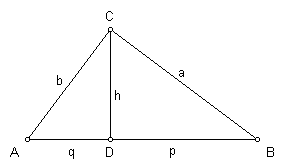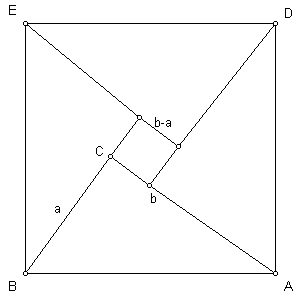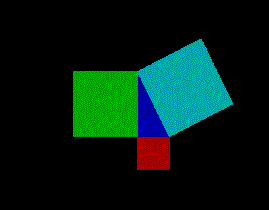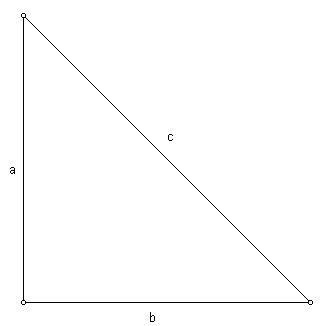The Pythagorean Theorem
Lesson 2
Lesson By: Jonathan Challen
Prerequisites:
Before reaching this lesson, students should:
- Know basic triangle theorems (similarity theorems, congruence theorems, corresponding parts theorems, angle sum theorems).
- Know how to solve algebraic equations involving squares and square roots.
- Have basic knowledge in the use of the computer program, Geometer's Sketchpad.
Objectives:
- Discover the Pythagorean Theorem with the aid of a computer acitivity
- Explore methods of proving the Pythagorean Theorem
- Introduce the Pythagorean Theorem as a method of solving right triangle problems
- Find the length of the third side of a right triangle, given the other two sides
Overview:
- Previous Day's Review- History of Pythagorean Theorem (5 minutes)
- GSP Activity- Discovering the Pythagorean Theorem (20-30 minutes)
- Supplemental Activity- Similarity Proof (10 minutes)
- Supplemental Activity- Bhaskara's Proof (with animated image) (10 minutes)
- Introduce Pythagorean Theorem (explain equation, what variables represent, etc.) (5 minutes)
- Example Problems (2 examples) (10 minutes)
- Homework/Classwork- Practice Problems Worksheet (10 problems)
Note to Teachers: Supplemental activities are provided if extra time
is available. Without the supplemental activities, this entrie lesson can be completed in
one 50-minute class period. It is recommended to include the supplemental activities, if time
is available.
GSP Activity- Discovering the Pythagorean Theorem:
This activity requires the use of Geometer's Sketchpad, which is a computer program available
for both Macintosh and Windows. This activity may also require the use of a calculator to perform
simple arithmetic calculations, or students may use the calculator provided with GSP. Teachers
should allow students to work independently on this activity, providing only the basic outline of the
activity and allowing the students to create their own conjectures
regarding the information they find. Teachers should explain that the most important part of the activity
is answering the critical thinking questions fully and completely. Teachers should read each step and wait
for all students to complete the task before moving on to the next step.
THE GSP SKETCH FOR STUDENTS
THE GSP SKETCH FOR TEACHERS (already has steps completed)
The Activity
- Open the file "similar.gsp" in your folder
- Measure the following angles: ACB, BDC, ADC
- What do these angles have in common? (Answer: They are all 90 degree angles.)
- Measure the following angles: BCD, CAD, ACD, CBD
- What do you notice about these angles? (Answer: BCD and CAD are equal; CBD and ACD are equal)
- Why is this the case? (Answer: Since we know that all of the angles in a triangle add up to be 180 degrees, and
that angles ACB, BDC, and ADC are all 90 degrees, angle CAD + angle ACD = 90 and angle BCD + angle CBD = 90.
Since angle BCD + angle ACD = 90 (they form angle ACB, which we know is 90 degrees), we can then deduce that
angles CBD and ACD are equal and angles BCD and CAD are equal.)
- What do these equal angles tell us about triangles CBD and ACD? (Answer: They are similar triangles, by the
AA-similarity theorem.)
- What does this tell us about these triangles with relation to the large triangle (ABC)? (Answer both of the
smaller triangles (CBD and ACD) are similar to the larger triangle (ABC) by AA-similarity.)
- Measure the following side lengths: AB, BC, and BD
- Do the following computations: BD/BC and BC/AB
- What do you notice about these computations? (Answer: They are the same value.)
- Why is this the case? (Answer: The side lengths of similar triangles are proportional.)
- Measure the following side lengths: AC and AD
- Do the following computations: AD/AC and AC/AB
- What do you notice about these computations? (Answer: They are the same value.)
- Why is this the case? (Answer: The side lengths of similar triangles are proportional.)
- Look at these two sets of proportions. Set up two equations based on those proportions. (Answer: BD/BC=BC/AB and AD/AC=AC/AB)
- Now solve these equations for BD and AD and do these computations on GSP. (Answer: BD=BC2/AB and AD=AC2/AB)
- What do we know about the sum of BD and AD? Do this computation on GSP. (Answer: It equals AB.)
- Use this sum to find an equation for AB and do the computation on GSP. (Answer: AB = BC2/AB + AC2/AB)
- If we multiply this equation through by AB, what equation do we get? (Answer: AB2 = BC2 + AC2)
- What is the significance of this equation? (It is the Pythagorean Theorem!)
- Check the Pythagorean Theorem using your GSP sketch (compute AC2 + BC2 and AB2 and compare).
Similarity Proof:

ABC is a right triangle, with the right angle at angle ACB. An altitude is dropped
from vertex C, forming right angles at angle CDB and angle CDA. Since all angles in a
triangle must sum to 180 degrees, the sum of angle CAD and angle ACD is 90, as is the
sum of angle CBD and angle BCD. Therefore, angle CAD must equal angle BCD and angle
CBD must equal angle ACD. Thus, we have the angles in triangle ACD and triangle CBD
equal. By the AA-similarity theorem, these triangles must be similar. We can then set up the following proportions:
Since p + q = c, we get:
And finally:
Bhaskara's Proof:

The Bhaskara figure contains a small square within a larger square and forms four
right triangles inside the larger square. The length of the sides of the larger square
are c, and the lengths of the legs of the right triangles are a and b.
An easy deduction leads to the smaller square's sides being b - a. Thus, the
area of the larger square can be used to prove the Pythagorean Theorem:
Here is a very nice animation of a similar proof which can help you visualize how Bhaskara's proof works:
The Pythagorean Theorem:
The Pythagorean Theorem states:
a2 + b2 = c2
for a right triangle with legs a and b and hypotenuse c.
Example Problems:
Use this figure to find the missing side length. (There is a right angle between sides a and b.)
1. If a = 3 and b = 4, find the length of c.
a2 + b2 = c2
32 + 42 = c2
9 + 16 = c2
25 = c2
5 = c
2. If a = 4 and c = 11, find the length of b.
a2 + b2 = c2
42 + b2 = 112
16 + b2 = 121
b2 = 105
b = 10.25
Practice Problems:
Use this figure to find the missing side length. (There is a right angle between sides a and b.)
1. If a = 1 and b = 2, find the length of c. (Answer: 2.236)
2. If a = 5 and b = 7, find the length of c. (Answer: 8.602)
3. If a = 6 and b = 2, find the length of c. (Answer: 6.325)
4. If a = 1 and b = 1, find the length of c. (Answer: 1.414)
5. If a = 4 and c = 10, find the length of b. (Answer: 9.165)
6. If a = 7 and c = 9, find the length of b. (Answer: 5.657)
7. If a = 1 and c = 4, find the length of b. (Answer: 3.873)
8. If b = 5 and c = 25, find the length of a. (Answer: 24.495)
9. If b = 4 and c = 13, find the length of a. (Answer: 12.369)
10. If b = 2 and c = 10, find the length of a. (Answer: 9.798)
Return to Home Page







